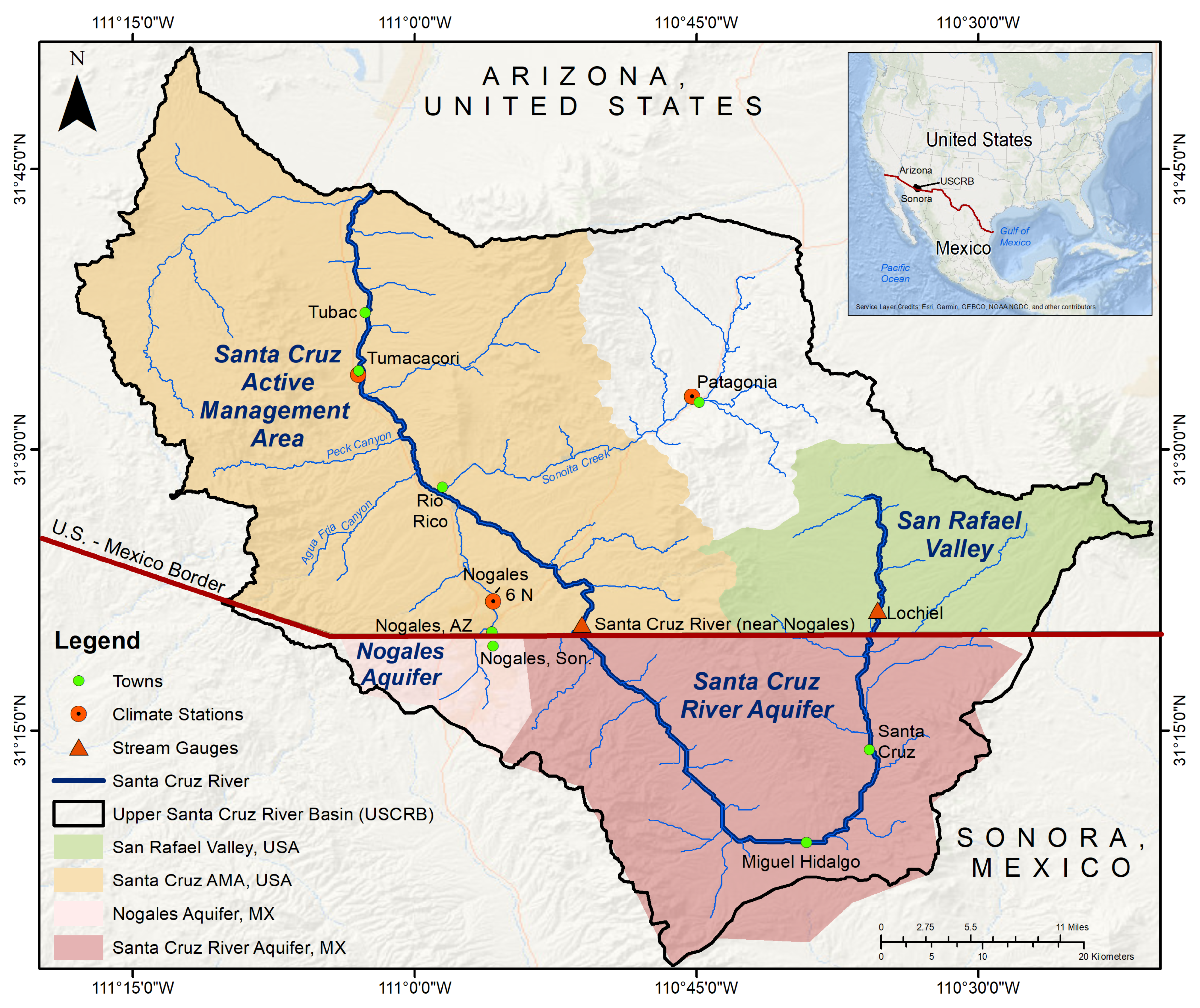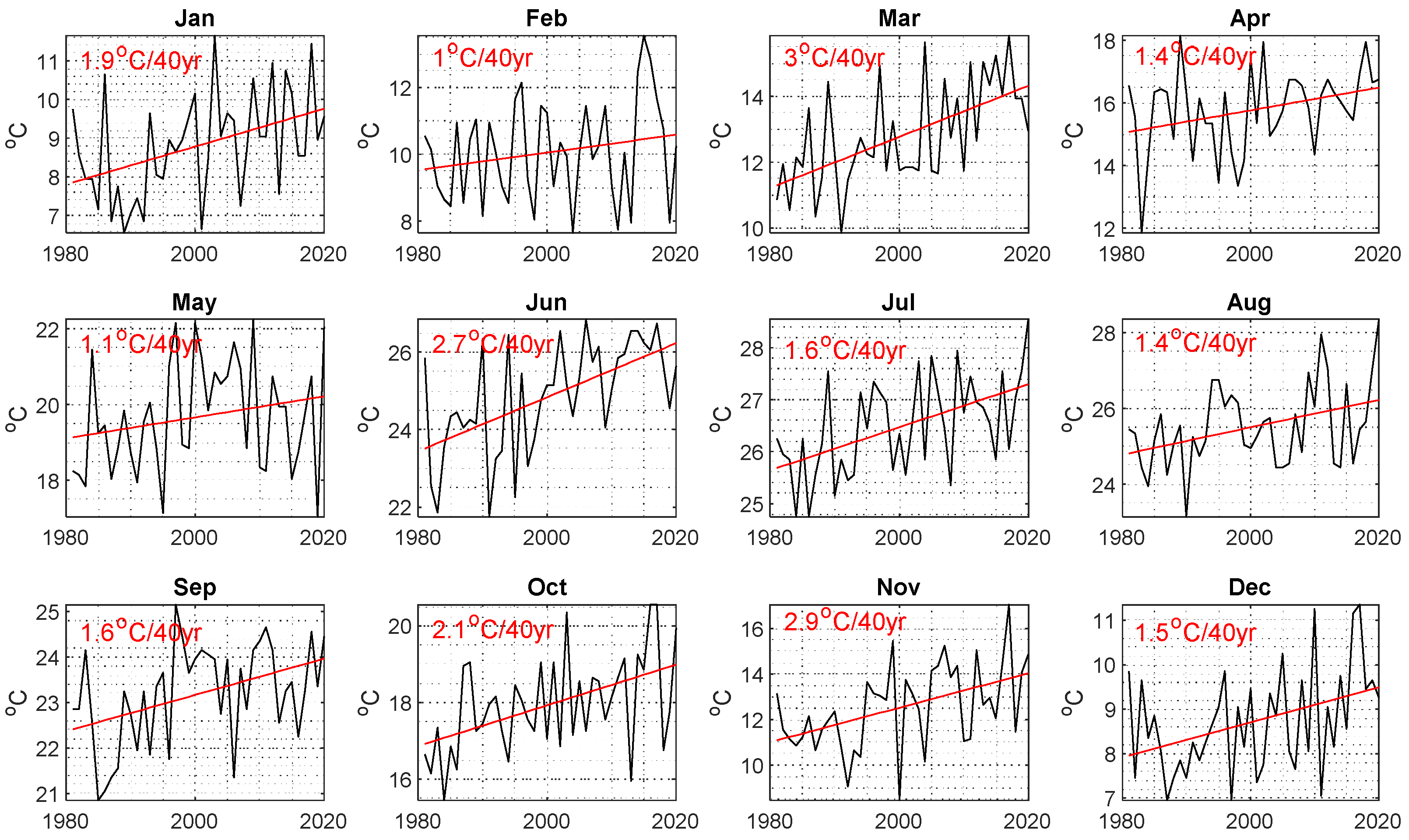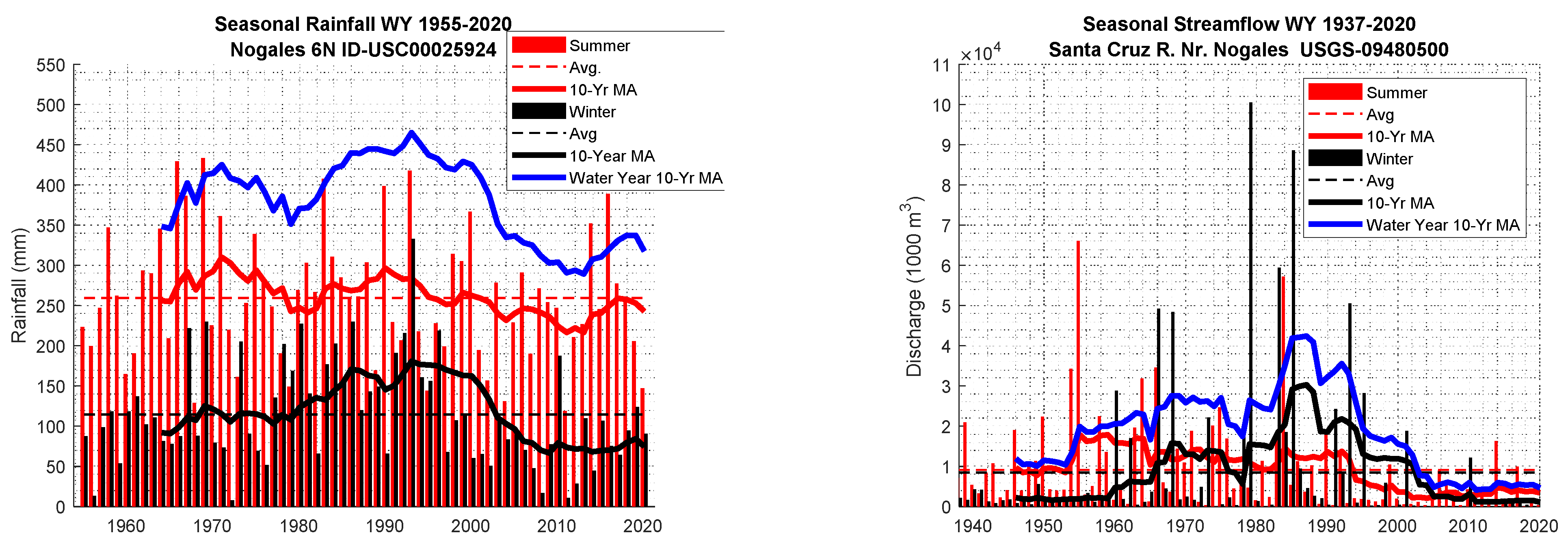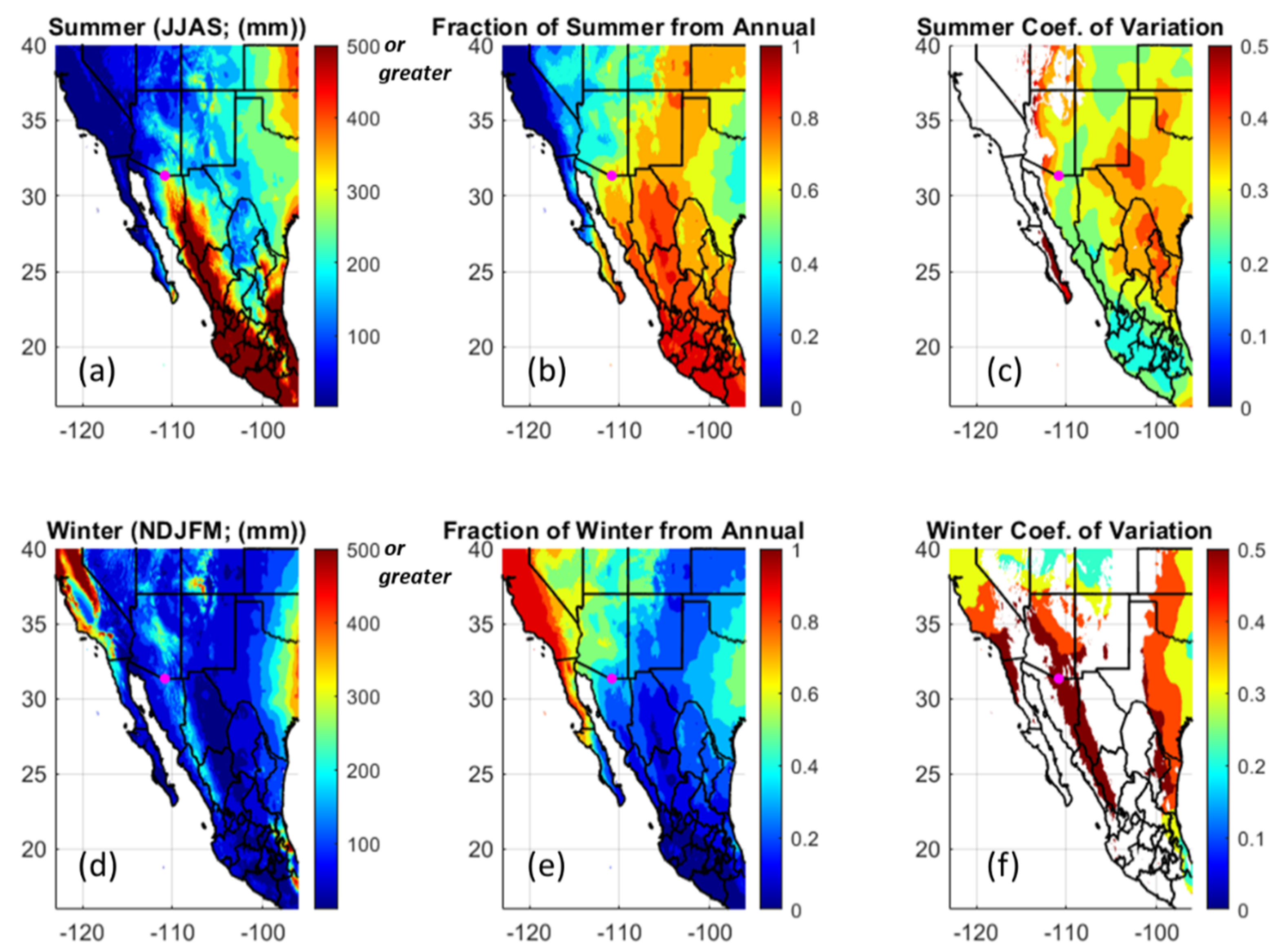A Review of Climate Change Impacts on the USA-Mexico Transboundary Santa Cruz River Basin
Abstract
1. Introduction
2. Study Area
3. Climate and Historical Trends
4. Summer
4.1. Historical Changes
4.2. Future Projections
5. Winter
Future Projections
6. Tropical Storms
7. Previous Climate Assessment Studies in the Region
8. Summary
Author Contributions
Funding
Institutional Review Board Statement
Informed Consent Statement
Data Availability Statement
Acknowledgments
Conflicts of Interest
Abbreviations
| AET | Actual Evapotranspiration |
| AR | Atmospheric River |
| CMIP3 or 5 | Coupled Model Intercomparison Project (CMIP) phase 3 or 5 |
| ENSO | El Niño and the Southern Oscillation |
| ET | Evapotranspiration |
| GCM | Global Climate Model |
| GHG | Green House Gas |
| IBWC | International Boundary and Water Commission |
| MCM | Million Cubic Meter |
| NAM | North American Monsoon |
| NMSA | Northern Mexico and Southern Arizona |
| PET | Potential Evapotranspiration |
| RCP | Representative Concentration Pathway |
| RCM | Regional Climate Model |
| SST | Sea Surface Temperature |
| TC | Tropical Cyclone |
| USCRB | Upper Santa Cruz River Basin |
References
- IBWC. Joint Report of the Principal Engineers Regarding Joint Cooperative Process. United States-Mexico for the Transboundary Aquifer Assessment Program. 2009. Available online: Wrrc.arizona.edu/sites/wrrc.arizona.edu/files/images/Joint-Report-TAAP-8-19-09.pdf (accessed on 13 May 2021).
- Megdal, S.B.; Scott, C.A. The Importance of Institutional Asymmetries to the Development of Binational Aquifer Assessment Programs: The Arizona-Sonora Experience. Water 2011, 3, 949–963. [Google Scholar] [CrossRef]
- Callegary, J.; Megdal, S.; Villaseñor, E.T.; Petersen-Perlman, J.; Sosa, I.M.; Monreal, R.; Gray, F.; Noriega, F.G. Findings and lessons learned from the assessment of the Mexico-United States transboundary San Pedro and Santa Cruz aquifers: The utility of social science in applied hydrologic research. J. Hydrol. Reg. Stud. 2018, 20, 60–73. [Google Scholar] [CrossRef]
- Tapia-Villaseñor, E.; Megdal, S. The U.S.-Mexico Transboundary Aquifer Assessment Program as a Model for Transborder Groundwater Collaboration. Water 2021, 13, 530. [Google Scholar] [CrossRef]
- Garfin, G.M.; Gonzalez, P.; Breshears, D.; Brooks, K.; Brown, H.E.; Elias, E.; Gunasekara, A.; Huntly, N.; Maldonado, J.K.; Mantua, N.J.; et al. Chapter 25: Southwest. Impacts, Risks, and Adaptation in the United States. In The Fourth National Climate Assessment; U.S. Global Change Research Program: Washington, DC, USA, 2018; Volume 2, pp. 1101–1184. [Google Scholar]
- Abatzoglou, J.T.; Brown, T.J. A comparison of statistical downscaling methods suited for wildfire applications. Int. J. Clim. 2011, 32, 772–780. [Google Scholar] [CrossRef]
- Shamir, E.; Halper, E. The Role of Downscaling Methodology in Projected Climate Change Impacts on Water Resources in Arid Environments; U.S. Department of Interior, Bureau of Reclamation Research and Development Office: Denver, CO, USA, 2019.
- Shamir, E.; Halper, E.; Modrick, T.; Georgakakos, K.P.; Chang, H.-I.; Lahmers, T.M.; Castro, C. Statistical and dynamical downscaling impact on projected hydrologic assessment in arid environment: A case study from Bill Williams River basin and Alamo Lake, Arizona. J. Hydrol. X 2019, 2, 2589–9155. [Google Scholar] [CrossRef]
- Shamir, E.; Megdal, S.B.; Carrillo, C.; Castro, C.L.; Chang, H.-I.; Chief, K.; Corkhill, F.E.; Eden, S.; Georgakakos, K.P.; Nelson, K.M.; et al. Climate change and water resources management in the Upper Santa Cruz River, Arizona. J. Hydrol. 2015, 521, 18–33. [Google Scholar] [CrossRef]
- Meixner, T.; Manning, A.H.; Stonestrom, D.A.; Allen, D.M.; Ajami, H.; Blasch, K.W.; Brookfield, A.E.; Castro, C.L.; Clark, J.F.; Gochis, D.J.; et al. Implications of projected climate change for groundwater recharge in the western United States. J. Hydrol. 2016, 534, 124–138. [Google Scholar] [CrossRef]
- Abatzoglou, J.T. Development of gridded surface meteorological data for ecological applications and modelling. Int. J. Clim. 2013, 33, 121–131. [Google Scholar] [CrossRef]
- Scott, C.; Megdal, S.; Oroz, L.; Callegary, J.; Vandervoet, P. Effects of climate change and population growth on the transboundary Santa Cruz aquifer. Clim. Res. 2012, 51, 159–170. [Google Scholar] [CrossRef]
- CONAGUA. Actualización de la Disponibilidad Media Anual de Agua en el Acuífero Río Santa Cruz (2615) Estado de Sonora. Diario Oficial de la Federación (DOF). 2020. Available online: https://sigagis.conagua.gob.mx/gas1/sections/Edos/sonora/sonora.html (accessed on 17 May 2021).
- Arizona Department of Water Resources. Groundwater Flow Model of the Santa Cruz Active Management Area Along the Santa Cruz River and Nogales Wash from the International Border to Tubac; Arizona Department of Water Resources: Phoenix, AZ, USA, 2020.
- Tapia-Villaseñor, E.M.; Shamir, E.; Megdal, S.B.; Petersen-Perlman, J.D. Impacts of Variable Climate and Effluent Flows on the Transboundary Santa Cruz Aquifer. JAWRA J. Am. Water Resour. Assoc. 2020, 56, 409–430. [Google Scholar] [CrossRef]
- Shamir, E. The value and skill of seasonal forecasts for water resources management in the Upper Santa Cruz River basin, southern Arizona. J. Arid. Environ. 2017, 137, 35–45. [Google Scholar] [CrossRef]
- Nelson, K. Risk Assessment of Pumping Impacts on Simulated Groundwater Flow in the Santa Cruz Active Management Area; ADWR Modeling Report No. 21; Arizona Department of Water Resources: Phoenix, AZ, USA, 2010.
- Garfin, G.; Jardine, A.; Merideth, R.; Black, M.; LeRoy, S. Assessment of Climate Change in the Southwest United States: A Report Prepared for the National Climate Assessment; A report by the Southwest Climate Alliance; Island Press: Washington, DC, USA, 2013. [Google Scholar]
- Minjárez Sosa, I.; Monreal Saavedra, R.; Grijalva Noriega, F.J.; Ochoa Granillo, J.A.; Tapia Villaseñor, E.M.; Rangel Medina, M.; Montijo González, A. Actividades Hidrogeológicas en el Acuífero Río Santa Cruz, Estado de Sonora, Primera Etapa; Conagua: Hermosillo, Sonora, 2011. [Google Scholar]
- Serrat-Capdevila, A.; Scott, R.L.; Shuttleworth, W.J.; Valdés, J.B. Estimating evapotranspiration under warmer climates: Insights from a semi-arid riparian system. J. Hydrol. 2011, 399, 1–11. [Google Scholar] [CrossRef]
- Villarreal, M.L.; Norman, L.M.; Webb, R.H.; Turner, R.M. Historical and Contemporary Geographic Data Reveal Complex Spatial and Temporal Responses of Vegetation to Climate and Land Stewardship. Land 2013, 2, 194–224. [Google Scholar] [CrossRef]
- Shilo, E.; Ziv, B.; Shamir, E.; Rimmer, A. Evaporation from Lake Kinneret, Israel, during hot summer days. J. Hydrol. 2015, 528, 264–275. [Google Scholar] [CrossRef]
- Castro, C.L.; Chang, H.-I.; Dominguez, F.; Carrillo, C.; E Schemm, J.; Juang, H.-M.H. Can a Regional Climate Model Improve the Ability to Forecast the North American Monsoon? J. Clim. 2012, 25, 8212–8237. [Google Scholar] [CrossRef]
- Higgins, R.W.; Shi, W. Relationships between Gulf of California Moisture Surges and Tropical Cyclones in the Eastern Pacific Basin. J. Clim. 2005, 18, 4601–4620. [Google Scholar] [CrossRef]
- Adam, D.K.; Comrie, A.C. The North American Monsoon. Bull. Am. Meteorol. Soc. 1997, 78, 2197–2214. [Google Scholar] [CrossRef]
- Wang, B.; Biasutti, M.; Byrne, M.P.; Castro, C.; Chang, C.; Cook, K.; Fu, R.; Grimm, A.M.; Ha, K.; Hendon, H. Climate Change Assessment. Bull. Am. Meteorol. Soc. 2021, 102, E1–E19. [Google Scholar] [CrossRef]
- Arriaga-Ramírez, S.; Cavazos, T. Regional trends of daily precipitation indices in northwest Mexico and southwest United States. J. Geophys. Res. Space Phys. 2010, 115, 14111. [Google Scholar] [CrossRef]
- Abatzoglou, J.T.; Dobrowski, S.Z.; Parks, S.A.; Hegewisch, K.C. TerraClimate, a high-resolution global dataset of monthly climate and climatic water balance from 1958–2015. Sci. Data 2018, 5, 170191. [Google Scholar] [CrossRef]
- Castro, C.L.; McKee, T.B.; Pielke, R.A. The Relationship of the North American Monsoon to Tropical and North Pacific Sea Surface Temperatures as Revealed by Observational Analyses. J. Clim. 2001, 14, 4449–4473. [Google Scholar] [CrossRef]
- Shamir, E.; Meko, D.M.; Graham, N.E.; Georgakakos, K.P. Hydrologic Model Framework for Water Resources Planning in the Santa Cruz River, Southern Arizona. JAWRA J. Am. Water Resour. Assoc. 2007, 43, 1155–1170. [Google Scholar] [CrossRef]
- Chang, H.-I.; Castro, C.L.; Carrillo, C.M.; Dominguez, F. The more extreme nature of U.S. warm season climate in the recent observational record and two “well-performing” dynamically downscaled CMIP3 models. J. Geophys. Res. Atmos. 2015, 120, 8244–8263. [Google Scholar] [CrossRef]
- Pascale, S.; Carvalho, L.M.V.; Adams, D.K.; Castro, C.L.; Cavalcanti, I.F.A. Current and Future Variations of the Monsoons of the Americas in a Warming Climate. Curr. Clim. Chang. Rep. 2019, 5, 125–144. [Google Scholar] [CrossRef]
- Luong, T.M.; Castro, C.L.; Chang, H.-I.; Lahmers, T.; Adams, D.K.; Ochoa-Moya, C.A. The More Extreme Nature of North American Monsoon Precipitation in the Southwestern United States as Revealed by a Historical Climatology of Simulated Severe Weather Events. J. Appl. Meteorol. Clim. 2017, 56, 2509–2529. [Google Scholar] [CrossRef]
- Castro, C.L.; Pielke, R.A.; Adegoke, J.O.; Schubert, S.D.; Pegion, P.J. Investigation of the Summer Climate of the Contiguous United States and Mexico Using the Regional Atmospheric Modeling System (RAMS). Part II: Model Climate Variability. J. Clim. 2007, 20, 3866–3887. [Google Scholar] [CrossRef]
- DeMaria, E.M.C.; Hazenberg, P.; Scott, R.L.; Meles, M.B.; Nichols, M.; Goodrich, D. Intensification of the North American Monsoon Rainfall as Observed From a Long-Term High-Density Gauge Network. Geophys. Res. Lett. 2019, 46, 6839–6847. [Google Scholar] [CrossRef]
- Thomas, B.E.; Pool, D.R. Trends in streamflow of the San Pedro River, southeastern Arizona, and regional trends in precipitation and streamflow in southeastern Arizona and southwestern New Mexico. Prof. Paper US Geol. Surv. 2006, 1712, 79. [Google Scholar]
- Shamir, E.; Wang, J.; Georgakakos, K.P. Probabilistic Streamflow Generation Model for Data Sparse Arid Watersheds. JAWRA J. Am. Water Resour. Assoc. 2007, 43, 1142–1154. [Google Scholar] [CrossRef]
- Castro, L.C.; Chang, H.; Leuthold, M.; Luong, T.; Carrillo, C.; Mazon, J.; Stutler, J.; Jares, M.; Lahmers, T.; Cassell, W. Assessing Climate Change Impacts for DoD Installations in the Southwest United States during the Warm Season; University of Arizona Tucson United States: Tucson, AZ, USA, 2017; p. 128. [Google Scholar]
- Bukovsky, M.S. Temperature Trends in the NARCCAP Regional Climate Models. J. Clim. 2012, 25, 3985–3991. [Google Scholar] [CrossRef]
- Bukovsky, M.S.; Carrillo, C.M.; Gochis, D.J.; Hammerling, D.M.; McCrary, R.R.; Mearns, L.O. Toward Assessing NARCCAP Regional Climate Model Credibility for the North American Monsoon: Future Climate Simulations. J. Clim. 2015, 28, 6707–6728. [Google Scholar] [CrossRef]
- Geil, K.L.; Serra, Y.L.; Zeng, X. Assessment of CMIP5 Model Simulations of the North American Monsoon System. J. Clim. 2013, 26, 8787–8801. [Google Scholar] [CrossRef]
- Pascale, S.; Boos, W.R.; Bordoni, S.; Delworth, T.L.; Kapnick, S.B.; Murakami, H.; Vecchi, G.A.; Zhang, W. Weakening of the North American monsoon with global warming. Nat. Clim. Chang. 2017, 7, 806–812. [Google Scholar] [CrossRef]
- Maloney, E.D.; Camargo, S.J.; Chang, E.; A Colle, B.; Fu, R.; Geil, K.L.; Hu, Q.; Jiang, X.; Johnson, N.C.; Karnauskas, K.B.; et al. North American Climate in CMIP5 Experiments: Part III: Assessment of Twenty-First-Century Projections. J. Clim. 2014, 27, 2230–2270. [Google Scholar] [CrossRef]
- Torres-Alavez, A.; Cavazos, T.; Turrent, C. Land–Sea Thermal Contrast and Intensity of the North American Monsoon under Climate Change Conditions. J. Clim. 2014, 27, 4566–4580. [Google Scholar] [CrossRef]
- Cook, B.; Seager, R.D. The response of the North American Monsoon to increased greenhouse gas forcing. J. Geophys. Res. Atmos. 2013, 118, 1690–1699. [Google Scholar] [CrossRef]
- Colorado-Ruiz, G.; Cavazos, T.; Salinas, J.A.; De Grau, P.; Ayala, R. Climate change projections from Coupled Model Intercomparison Project phase 5 multi-model weighted ensembles for Mexico, the North American monsoon, and the mid-summer drought region. Int. J. Clim. 2018, 38, 5699–5716. [Google Scholar] [CrossRef]
- Maddox, R.A.; Mccollum, D.M.; Howard, K.W. Large-Scale Patterns Associated with Severe Summertime Thunderstorms over Central Arizona. Weather. Forecast. 1995, 10, 763–778. [Google Scholar] [CrossRef]
- Magirl, C.S.; Webb, R.H.; Griffiths, P.G.; Schaffner, M.; Shoemaker, C.; Pytlak, E.; Yatheendradas, S.; Lyon, S.W.; Troch, P.A.; Desilets, S.L.E.; et al. Impact of recent extreme Arizona storms. Eos Trans. Am. Geophys. Union 2007, 88, 191–193. [Google Scholar] [CrossRef]
- Redmond, K.T.; Koch, R.W. Surface Climate and Streamflow Variability in the Western United States and Their Relationship to Large-Scale Circulation Indices. Water Resour. Res. 1991, 27, 2381–2399. [Google Scholar] [CrossRef]
- Sheppard, P.R.; Comrie, A.C.; Packin, G.D.; Angersbach, K.; Hughes, M.K. The climate of the US Southwest. Clim. Res. 2002, 21, 219–238. [Google Scholar] [CrossRef]
- Kim, S. An Assessment of Atmospheric Rivers as Flood Produces in Arizona. Master’s Thesis, Hydrology and Water Resources, University of Arizona, Tucson, AZ, USA, 2015; 134p. [Google Scholar]
- Neiman, P.J.; Ralph, F.M.; Moore, B.J.; Hughes, M.; Mahoney, K.M.; Cordeira, J.M.; Dettinger, M.D. The Landfall and Inland Penetration of a Flood-Producing Atmospheric River in Arizona. Part I: Observed Synoptic-Scale, Orographic, and Hydrometeorological Characteristics. J. Hydrometeorol. 2013, 14, 460–484. [Google Scholar] [CrossRef]
- Rutz, J.J.; Steenburgh, W.J. Quantifying the role of atmospheric rivers in the interior western United States. Atmos. Sci. Lett. 2012, 13, 257–261. [Google Scholar] [CrossRef]
- Rutz, J.J.; Steenburgh, W.J.; Ralph, F.M. The Inland Penetration of Atmospheric Rivers over Western North America: A Lagrangian Analysis. Mon. Wea. Rev. 2015, 143, 1924–1944. [Google Scholar] [CrossRef]
- Dettinger, M.D. Fifty-Two Years of “Pineapple-Express” Storms Across the West Coast of North America US Geological Survey, Scripps Institution of Oceanography for the California Energy Commission; California Energy Commission: Sacramento, CA, USA, 2004.
- Neelin, J.D.; Langenbrunner, B.; Meyerson, J.E.; Hall, A.; Berg, N. California Winter Precipitation Change under Global Warming in the Coupled Model Intercomparison Project Phase 5 Ensemble. J. Clim. 2013, 26, 6238–6256. [Google Scholar] [CrossRef]
- Cook, B.I.; Ault, T.R.; Smerdon, J.E. Unprecedented 21st century drought risk in the American Southwest and Central Plains. Sci. Adv. 2015, 1, e1400082. [Google Scholar] [CrossRef] [PubMed]
- Dettinger, M.D. Climate Change, Atmospheric Rivers, and Floods in California - A Multimodel Analysis of Storm Frequency and Magnitude Changes1. JAWRA J. Am. Water Resour. Assoc. 2011, 47, 514–523. [Google Scholar] [CrossRef]
- Gao, Y.; Lu, J.; Leung, L.R.; Yang, Q.; Hagos, S.; Qian, Y. Dynamical and thermodynamical modulations on future changes of landfalling atmospheric rivers over western North America. Geophys. Res. Lett. 2015, 42, 7179–7186. [Google Scholar] [CrossRef]
- Warner, M.D.; Mass, C.F.; Salathé, E.P. Changes in Winter Atmospheric Rivers along the North American West Coast in CMIP5 Climate Models. J. Hydrometeorol. 2015, 16, 118–128. [Google Scholar] [CrossRef]
- Payne, A.E.; Magnusdottir, G. An evaluation of atmospheric rivers over the North Pacific in CMIP5 and their response to warming under RCP 8.5. J. Geophys. Res. Atmos. 2015, 120, 11–173. [Google Scholar] [CrossRef]
- Gershunov, A.; Shulgina, T.; Clemesha, R.E.S.; Guirguis, K.; Pierce, D.W.; Dettinger, M.D.; Lavers, D.A.; Cayan, D.R.; Polade, S.D.; Kalansky, J.; et al. Precipitation regime change in Western North America: The role of Atmospheric Rivers. Sci. Rep. 2019, 9, 1–11. [Google Scholar] [CrossRef]
- Shields, C.A.; Kiehl, J.T. Atmospheric river landfall-latitude changes in future climate simulations. Geophys. Res. Lett. 2016, 43, 8775–8782. [Google Scholar] [CrossRef]
- Ritchie, E.A.; Wood, K.M.; Gutzler, D.S.; White, S.R. The Influence of Eastern Pacific Tropical Cyclone Remnants on the Southwestern United States. Mon. Weather. Rev. 2011, 139, 192–210. [Google Scholar] [CrossRef]
- Knutson, T.; Camargo, S.J.; Chan, J.C.L.; Emanuel, K.; Ho, C.-H.; Kossin, J.; Mohapatra, M.; Satoh, M.; Sugi, M.; Walsh, K.; et al. Tropical Cyclones and Climate Change Assessment: Part I: Detection and Attribution. Bull. Am. Meteorol. Soc. 2019, 100, 1987–2007. [Google Scholar] [CrossRef]
- Knutson, T.; Camargo, S.J.; Chan, J.C.L.; Emanuel, K.; Ho, C.-H.; Kossin, J.; Mohapatra, M.; Satoh, M.; Sugi, M.; Walsh, K.; et al. Tropical Cyclones and Climate Change Assessment: Part II: Projected Response to Anthropogenic Warming. Bull. Am. Meteorol. Soc. 2020, 101, E303–E322. [Google Scholar] [CrossRef]
- Magaña, V.; Zermeño, D.; Neri, C. Climate change scenarios and potential impacts on water availability in northern Mexico. Clim. Res. 2012, 51, 171–184. [Google Scholar] [CrossRef]
- Dominguez, F.; Cañon, J.; Valdes, J. IPCC-AR4 climate simulations for the Southwestern US: The importance of future ENSO projections. Clim. Chang. 2010, 99, 499–514. [Google Scholar] [CrossRef]
- Ajami, H.; Meixner, T.; Dominguez, F.; Hogan, J.; Maddock, T. Seasonalizing mountain system recharge in semi-arid basins—climate change impacts. Groundwater 2012, 50, 585–597. [Google Scholar] [CrossRef]
- Serrat-Capdevila, A.; Valdés, J.B.; Pérez, J.G.; Baird, K.; Mata, L.J.; Maddock III, T. Modeling climate change impacts–and uncertainty–on the hydrology of a riparian system: The San Pedro Basin (Arizona/Sonora). J. Hydrol. 2007, 347, 48–66. [Google Scholar] [CrossRef]





| Summer | Winter | |
|---|---|---|
| Precipitation (mm) | ||
| 1955–2000 | 259 | 115 |
| 2001–2020 | 233 (10%) | * 77 (33%) |
| Streamflow (MCM) | ||
| 1937–2000 | 9.2 | 8.5 |
| 2001–2020 | * 3.2 (65%) | * 1.9 (78%) |
Publisher’s Note: MDPI stays neutral with regard to jurisdictional claims in published maps and institutional affiliations. |
© 2021 by the authors. Licensee MDPI, Basel, Switzerland. This article is an open access article distributed under the terms and conditions of the Creative Commons Attribution (CC BY) license (https://creativecommons.org/licenses/by/4.0/).
Share and Cite
Shamir, E.; Tapia-Villaseñor, E.M.; Cruz-Ayala, M.-B.; Megdal, S.B. A Review of Climate Change Impacts on the USA-Mexico Transboundary Santa Cruz River Basin. Water 2021, 13, 1390. https://doi.org/10.3390/w13101390
Shamir E, Tapia-Villaseñor EM, Cruz-Ayala M-B, Megdal SB. A Review of Climate Change Impacts on the USA-Mexico Transboundary Santa Cruz River Basin. Water. 2021; 13(10):1390. https://doi.org/10.3390/w13101390
Chicago/Turabian StyleShamir, Eylon, Elia M. Tapia-Villaseñor, Mary-Belle Cruz-Ayala, and Sharon B. Megdal. 2021. "A Review of Climate Change Impacts on the USA-Mexico Transboundary Santa Cruz River Basin" Water 13, no. 10: 1390. https://doi.org/10.3390/w13101390
APA StyleShamir, E., Tapia-Villaseñor, E. M., Cruz-Ayala, M.-B., & Megdal, S. B. (2021). A Review of Climate Change Impacts on the USA-Mexico Transboundary Santa Cruz River Basin. Water, 13(10), 1390. https://doi.org/10.3390/w13101390







